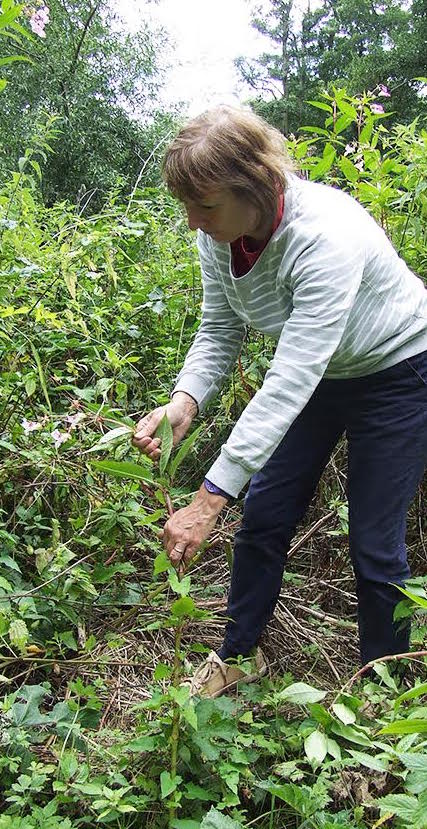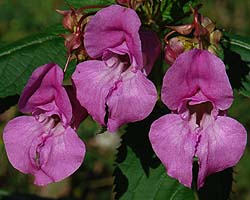 Abraham Lincoln
If given the truth, the people can be depended upon to meet any national crisis...
Abraham Lincoln
If given the truth, the people can be depended upon to meet any national crisis...
 Guildford news...
for Guildford people, brought to you by Guildford reporters - Guildford's own news service
Guildford news...
for Guildford people, brought to you by Guildford reporters - Guildford's own news service
Canal Trust Fighting A Pretty Nasty Invader
Published on: 4 Aug, 2015
Updated on: 11 Aug, 2015

Wey & Arun Canal Trust chairman Sally Schupke tackles a patch of invasive Himalayan balsam in Hunt Nature Park at Shalford.
Volunteers have been pulling up pretty flowering plants because it is feared they are a huge threat to a waterway restoration project in Surrey and Sussex.
Workers have been “bashing” Himalayan balsam along the route of the Wey & Arun Canal, to reduce the possibility of damage being caused by the invasive species.
The charity’s Wednesday Group working party has pulled up patches of the plant along the Cranleigh Waters river at Shalford, near Guildford.
Another group has tackled the problem weed around the new viewing platform built by the Trust in its Hunt Nature Park in Shalford.
“Himalayan balsam has spread there since the river flooded during the winter of 2013,” said Canal Trust Chairman Sally Schupke. “We don’t like having to pull up attractive plants but they will take over the entire area and smother other species if we don’t remove them.

The Wey & Arun Canal Trust aims to re-establish the link between the Wey and Arun rivers to give a route from London to the south coast.
“If the plants are allowed to flower they each eventually scatter hundreds of seeds around and become a dense jungle which is even harder to tackle. All other vegetation gets shaded out and dies off, leaving canal and river banks bare in winter and highly vulnerable to erosion.”
The Trust’s volunteer lengthsmen, who help maintain sections of the canal, are trained to spot areas where the balsam has started to grow and report it for eradication. It has also been tackled at sites along the canal route down to its junction with the River Arun at Pallingham in West Sussex.
“It’s a constant job to keep watch for the balsam along the banks of our canal,” said Mrs Schupke. “I’m very grateful to all our volunteers for their efforts — it’s a back-breaking job controlling this major threat to our restoration project.”
Himalayan balsam, which has clusters of purplish pink flowers, can grow up to 10ft high. It was brought to the UK as a garden plant in 1839 and is now naturalised, becoming a particular nuisance where it has spread through its seeds floating along canals and rivers.
The plant is also a problem down stream on the Wey. Robert Craig the NT lengthsman, on the Guildford to Godalming stretch, often reports on his efforts against the unwelcome weed in his Riff Raff diary.
See also: Viewing Platform Is The Latest Feature of The Wey & Arun Project
Responses to Canal Trust Fighting A Pretty Nasty Invader
Leave a Comment Cancel replyPlease see our comments policy. All comments are moderated and may take time to appear.
Recent Articles
- Guildford Institute’s Crowdfunding Project for Accessible Toilet in its New Community and Wellbeing Centre
- Letter: Guildford – Another Opportunity Missed?
- Letter: GBC’s Corporate Strategy – Where Is the Ambition?
- My Memories of John Mayall at a Ground-breaking Gig in Guildford Nearly Six Decades Ago
- Westborough HMO Plans ‘Losing the Heart of the Street’ Says Resident
- College Invests to Boost Surrey’s Economy and Close Digital Skills Gap
- Community Lottery Brings Big Wins for Local Charities
- GBC Housing Plan Promises ‘A Vibrant Urban Neighbourhood’ Near Town Centre
- Hospital Pillows ‘Shortage’ at the Royal Surrey
- Updated: Caravans Set Up Camp at Ash Manor School


Recent Comments
- Ian Macpherson on Updated: Main Guildford to Godalming Road Closed Until August 1
- Sara Tokunaga on GBC Housing Plan Promises ‘A Vibrant Urban Neighbourhood’ Near Town Centre
- Michael Courtnage on Daily Mail Online Reports Guildford Has Highest-paid Council Officer
- Alan Judge on GBC Housing Plan Promises ‘A Vibrant Urban Neighbourhood’ Near Town Centre
- John Perkins on GBC Housing Plan Promises ‘A Vibrant Urban Neighbourhood’ Near Town Centre
- S Collins on GBC Housing Plan Promises ‘A Vibrant Urban Neighbourhood’ Near Town Centre
Search in Site
Media Gallery
Dragon Interview: Local Artist Leaves Her Mark At One of England’s Most Historic Buildings
January 21, 2023 / No Comment / Read MoreDragon Interview: Lib Dem Planning Chair: ‘Current Policy Doesn’t Work for Local People’
January 19, 2023 / No Comment / Read MoreA3 Tunnel in Guildford ‘Necessary’ for New Homes, Says Guildford’s MP
January 10, 2023 / No Comment / Read More‘Madness’ for London Road Scheme to Go Ahead Against ‘Huge Opposition’, Says SCC Leader
January 6, 2023 / No Comment / Read MoreCouncillor’s Son Starts Campaign for More Consultation on North Street Plan
December 30, 2022 / No Comment / Read MoreCounty Council Climbs Down Over London Road Works – Further ‘Engagement’ Period Announced
December 14, 2022 / No Comment / Read MoreDragon Interview: GBC Reaction to the Government’s Expected Decision to Relax Housing Targets
December 7, 2022 / No Comment / Read MoreHow Can Our Town Centre Businesses Recover? Watch the Shop Front Debate
May 18, 2020 / No Comment / Read More










Mary Bedforth
August 4, 2015 at 6:06 pm
Himalayan balsam grows abundantly in the ‘fen’ by the St Catherine’s footbridge, along the edge of the woodland between Shalford Meadow and the footbridge and now on the bank of the Meadow itself.
When the seed pods mature the seeds literally shoot out. Clever.
The Swingbridge charity used to have teams pull the plants but I have not seen them around for a year or two.
http://www.surreycaretrust.co.uk/our-programmes-home/community-boats/